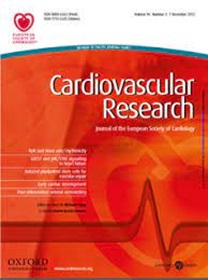与其他ApoB颗粒相比,二十碳五烯酸(EPA)限制了脂蛋白(a) [Lp(a)]的快速氧化
IF 13.3
1区 医学
Q1 CARDIAC & CARDIOVASCULAR SYSTEMS
引用次数: 0
摘要
目的:Lp(a)水平升高会增加心血管(CV)风险。Lp(a)含有氧化磷脂,可能比其他脂蛋白更能促进脂质氧化。高度不饱和的omega - 3脂肪酸EPA具有多个双键,可在共振结构中捕获自由基。纯化的乙基epa降低了Lp(a)升高的高危患者的CV事件,尽管Lp(a)相关的风险升高。由于Lp(a)在氧化脂质中富集,我们假设Lp(a)富集的血浆比其他含载脂蛋白的颗粒经历更快速的氧化,并且EPA比低不饱和脂肪酸或其他降脂处理更有效地限制Lp(a)富集血浆的氧化。这种特性可以限制内皮细胞的应激反应。方法与结果Lp(a)富集为&;gt;50%的总载脂蛋白ob含量类似于Lp(a)相关的“高风险”表型,并通过等重离心与小密度LDL (sdLDL)和VLDL的匹配水平进行比较。37℃±EPA(50µM)孵育30 min。氧化是由硫酸铜引发的,并通过丙二醛的形成来监测。我们还对EPA进行了氧化处理,然后与其他长链、低饱和脂肪酸和降脂剂进行了比较,测定了其抗氧化活性。人脐静脉内皮细胞(HUVECs)与富集Lp(a)的血浆孵育,在没有和存在EPA的情况下进行氧化。然后通过基于LC/ ms的全局蛋白质组学分析细胞裂解液样品,以发现蛋白质表达的显著变化(1倍)。Lp(a)富集的血浆中含有最高的基线氧化脂质(p<0.05),并且氧化速度最快。但在4小时内,不饱和脂肪酸和脂质剂均未减弱各组分的氧化作用(p<0.01)。氧化后的EPA抗氧化能力随氧化程度的增加而降低。用EPA抑制Lp(a)氧化也可以减轻促炎反应和细胞应激反应中蛋白表达的变化。结论:与其他含载脂蛋白相比,Lp(a)富集的血浆发生了更快速的氧化,并促进了EC蛋白表达的炎症变化,这一过程被EPA减弱。在Lp(a)水平升高的患者中,这一作用可能有助于EPA降低CV风险。本文章由计算机程序翻译,如有差异,请以英文原文为准。
Eicosapentaenoic acid (EPA) limits the more rapid oxidation of lipoprotein(a) [Lp(a)] compared with other ApoB particles
Aims Elevated Lp(a) levels increase cardiovascular (CV) risk. Lp(a) contains oxidized phospholipids that may promote lipid oxidation more than other lipoproteins. The highly unsaturated omega˗3 fatty acid EPA has multiple double bonds that can trap free radicals in resonance structures. Purified ethyl-EPA reduced CV events in high-risk patients with elevated Lp(a) despite Lp(a)-associated risk elevation. Since Lp(a) is enriched in oxidized lipids, we hypothesized that Lp(a)-enriched plasma undergoes more rapid oxidation than other ApoB-containing particles, and that EPA limits oxidation of Lp(a)-enriched plasma more effectively than less-unsaturated fatty acids or other lipid lowering treatments. This property could limit the cellular stress responses in endothelial cells. Methods and Results Lp(a) was enriched to >50% total ApoB content to resemble an Lp(a)-associated “high risk” phenotype and compared with matching levels of small-dense LDL (sdLDL) and VLDL by isopycnic centrifugation. Samples were then incubated ± EPA (50 µM) at 37°C for 30 min. Oxidation was initiated with copper sulfate and monitored by malondialdehyde formation. We also subjected EPA to oxidation before measuring its antioxidant activity as compared with other long chain, less saturated fatty acids and lipid lowering agents. Human umbilical vein ECs (HUVECs) were incubated with Lp(a)-enriched plasma following oxidation in the absence and presence of EPA. Cell lysate samples were then analyzed by global LC/MS-based proteomics for significant changes in protein expression (>1-fold). Lp(a)-enriched plasma contained the highest baseline oxidized lipid (p<0.05) and underwent the most rapid oxidation. EPA, but neither the less unsaturated fatty acids nor lipid agents attenuated oxidation of each fraction through 4 hours (p<0.01). Oxidized EPA had diminished antioxidant capacity corresponding to the extent of oxidation. Attenuation of Lp(a) oxidation with EPA also mitigated pro-inflammatory and cellular stress response changes in protein expression. Conclusions Lp(a)-enriched plasma underwent more rapid oxidation than other ApoB-containing lipoproteins and promoted inflammatory changes in EC protein expression, a process attenuated by EPA. This action may contribute to reduced CV risk by EPA in those with elevated Lp(a) levels.
求助全文
通过发布文献求助,成功后即可免费获取论文全文。
去求助
来源期刊

Cardiovascular Research
医学-心血管系统
CiteScore
21.50
自引率
3.70%
发文量
547
审稿时长
1 months
期刊介绍:
Cardiovascular Research
Journal Overview:
International journal of the European Society of Cardiology
Focuses on basic and translational research in cardiology and cardiovascular biology
Aims to enhance insight into cardiovascular disease mechanisms and innovation prospects
Submission Criteria:
Welcomes papers covering molecular, sub-cellular, cellular, organ, and organism levels
Accepts clinical proof-of-concept and translational studies
Manuscripts expected to provide significant contribution to cardiovascular biology and diseases
 求助内容:
求助内容: 应助结果提醒方式:
应助结果提醒方式:


